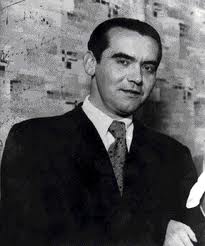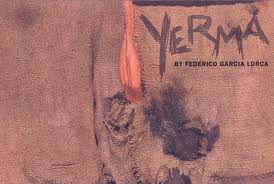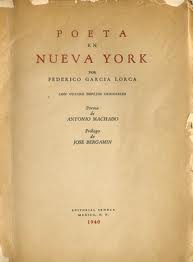Works of Federico Garcia Lorca
Federico Garcia Lorca is considered the best Spanish poet of the 20th century. His poetry captivated his contemporaries and has continued to influence later generations. His early and unjust death was a tragedy to the Spanish literature, but it also created a myth around the man that continues to grow with anyone that discovers his works.
Federico Garcia Lorca - Works

The works of Federico Garcia Lorca are quite systematic: poetry, dramas and prose are all fed by obsessions -love, lust, sterility- and aesthetics. The variety of forms and shades doesn't break the unity of the texts. Federico Garcia Lorca had quite a peculiar style, and he used a lot of symbols to convey the meaning of his works. Many of his symbols are related to Death, although the exact meaning can vary from text to text. They're studied more thoroughly in literary courses in Spain:
- The moon: it's the most common symbol in Lorca's works. It often means death, but it can also signify erotism, fertility, sterility or beauty.
- Water: running water means life, vitality, but still water means death.
- Blood: represents life, but spilled blood means death. It also symbolizes fertility and sex.
- The horse (and its rider): quite frequent in Lorca's texts, it's related to death, life and men's erotism.
- Grasses: signify death.
- Metals: their dominant meaning is death. Metals always appear as weapons, which always bring tragedy.

The metaphor is the most used literary form in Lorca's work. Under the influence of Luis de Góngora, Lorca uses quite risky metaphors, where the distance between the real term and the imaginary one is quite big. He's also a big fan of Neo-folklorism. Lorca never had a problem assimilating the new literary tendencies, but his work is full of traditional elements that denote his enormous literary culture. Music and traditional songs are constant presences in his poetry. However, from a formal point of view he's not a poet who shows the variety of the traditional forms, instead he chooses to delve in the traditional aspects of his people and the country he lived in.
Poetry
Federico Garcia Lorca was, above all, a poet. His poetry is considered the peak of the literature of the Generation of '27, and of all the Spanish literature. It's a reflection of the tragic feeling of life, and it's linked to several authors, traditions and literary movements. In Lorca's poetry, the popular and folkloric meets the cult and educated. Although it's hard to establish periods in Lorca's work, some people have divided it into two periods: The youth period and the plenitude period.
Youth Period
His first works are included in this period: "Impresiones y paisajes" (written in prose, although it does have some characteristic of the poetic language) and "Libro de poemas" (written under the influence of Ruben Dario, JUan Ramon Jimenez and Antonio Machado). In the latter, Federico Garcia Lorca projects a love without hope, doomed to sadness.
Plenitude period
It begins with "Poema de Cante Jondo" (1921) which, through the thematic, formal and conceptual unity and the expression of feelings, describes the Neo-folkloric poetry of the Generation of '27. In "Primeras canciones" (1927) and "Canciones" (1936) he uses the same forms: songs and ballads. Topics on time and death are framed by dawn, night, the Andalusian city of Granada and the lunar landscapes.
Death and the incompatibilities of the gypsy world with the bourgeoisie are the two great topics of the Romancero gitano (Gypsy Ballads). This book is not a folkloric text; it's based on the topics associated to the gypsies and the Andalusians. Lorca elevated gypsies to the level of literary myths, the same thing he would do later on with Jews and blacks in "Poeta en Nueva York".
Federico Garcia Lorca wrote "Poeta en Nueva York" after his time in the US, where he lived between 1929 and 1930. He thinks the modern life and nature are incompatible. His vision of New York is of nightmares and desolation, and to express the anguish and craving for communication that fill him., he uses the visionary images of the Surrealism movement.

"El Divan de Tamarit" (1940) is a poem book with an Oriental flavor, inspired in the collections of the Moorish-Andalusian poetry. The central topic is love, subject to frustrating and bitter experiences. The language is similar to the one used in "Poeta en Nueva York". "Llanto por la muerte de Ignacio Sánchez Mejías" (1935) is an elegy, an homage to the Sevillian bullfighter that was Lorca's friend.
Federico Garcia Lorca has always had the respect and admiration of the poets of literary generations after the Spanish Civil War.
Theatre
Federico Garcia Lorca's plays are, together with Valle-Inclan's, the most important ones written in Spanish in the 20th century. It's a poetic theatre, in the sense that it revolves around important symbols (blood, knives and roses), takes place in mythical settings and that it faces substantial problems about existence.
The language is also poetic, similar to Valle-Inclan's. Another of Lorca's influences is the Modernist drama (visible in his use of the verse), the theatre of Lope de Vega (evident in the use of folkloric songs), the theatre of Calderón (seen in the excessive use of tragedy) and the puppet tradition. The theatrical works of Federico Garcia Lorca can be assembled into four groups: Farces, comedies (unrepresentable, Lorca called them), tragedies and dramas.
Among the farces, written between 1921 and 1928, the most important ones are "La zapatera prodigiosa" and "Amor de don Perlimplín con Belisa en su jardín". This last complex play announces Lorca's unrepresentable dramas: "El público" and "Así que pasen cinco años" are his most hermetic plays. The first one talks about homosexuality and the second one delves inside humans and the sense of life.
Lorca wrote "Bodas de Sangre" (1933) and "Yerma" (1934) in the line of the poetic rural dramas that were so popular in that period. They're a mixture of myth and poetry. "Doña Rosita la soltera" (1935) and "La Casa de Bernarda Alba" (1936), which is thought by many to be the best book Lorca ever wrote, are examples of his worries towards the human problems like the feminine repression.

